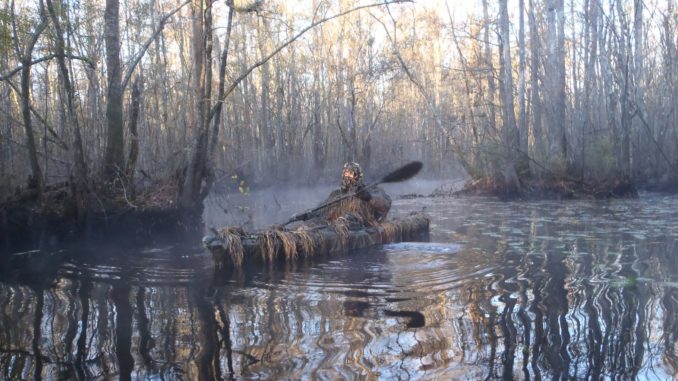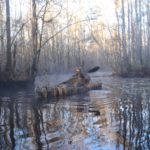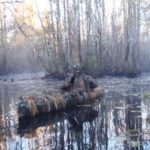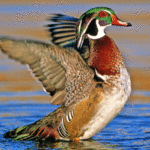
Low-lying swamps, backwaters around Brunswick County’s Town Creek are Ground Zero for paddling up some woodies.
Suddenly, the low, waking-up buzz of the swamp along Town Creek was pierced by the high-pitched squeal of a wood duck. It announced a trio strafing the decoys with all intentions of landing.
In the combination of their surprise to see hunters along the bank and the hunters’ surprise at the sudden appearance of ducks dive-bombing them, there was a split-second when the ducks changed direction and started frantically flapping towards the treetops to escape.
The surprise and delay actually worked in the hunters’ favor, as they had easier shots at ducks struggling to climb. Four shots rang out, and all three of the ducks splashed back to the surface of a small lagoon in the swamp.
Steve Goodwin pushed his kayak away from the bank to retrieve the fallen ducks, and in just a minute, he returned and showed off a pair of hens and a drake woodie.
“Sometimes, I wonder if wood ducks actually decoy or if they are just heading your way and drop in,” said Goodwin, his voice still showing excitement. “Sometimes, it seems like they have somewhere in mind when they leave the roost and are headed there regardless, and sometimes a single decoy or call will get them looking for you.”
Goodwin had barely eased his kayak back up against the bank when the next flock appeared down the creek — another pair of woodies making a beeline for the decoys.
When the hunters raised their shotguns, the ducks reacted and streaked for the treetops. They were already moving at flank speed, and the hunters didn’t fare so well. The multi-colored drake folded and tumbled back into the creek, but the hen never had her feathers ruffled and disappeared deeper into the swamp.
Goodwin, who serves as the special populations director for the Brunswick County Parks and Recreation Department, broke into a big smile and said, “I told you we would see some woodies right at first light. They’ve been in here every time I have been able to come. Now it will probably slow down for a while, and maybe we’ll see a few big ducks — or even some teal. There are a few big ducks around, but they usually move a little later than the woodies. Let’s give them a while to get stirring, and then we’ll see if we can’t jumpshoot our other woodies as we paddle back out.”
The morning’s action took place in one of the many sloughs that criss-cross the swamp surrounding Town Creek in Brunswick County, near Winnabow. While Town Creek is tidal, much of it is low-salinity brackish to fresh water, and some dense swamps around it except right around the mouth where it enters the Cape Fear River. Goodwin hunts the creek often and has developed an excellent understanding of the tides and how they affect morning or afternoon hunts and jump shooting during the day.
Two public access points serve Town Creek, but Goodwin and his friends had launched at a private ramp and headed several miles downstream with the last of the falling tide. The tide changed during the hunt, and the rising tide helped push the kayakers back to their put-in point.
Goodwin explained that using the tide allows kayakers to drift around bends with the current and be ready to shoot if ducks are in range. It also is perfect for a slow approach that sometimes allows getting within range of resting ducks without paddling and being ready and able to shoot when they flush.
“This is a great place to hunt and fish, but below the (US) 17 Bridge you need to always be paying attention,” Goodwin said. “The boat traffic isn’t too bad, but I usually try to hold to the side in case a boat comes around a curve on plane. However, boats aren’t the only issue in here. There are also alligators and snakes.
“Sometimes, the snakes can be territorial when the weather is warm, but they are usually hibernating by the time (duck) season comes in and aren’t an issue,” Goodwin said. “I’ve seen a few gators, especially while scouting early in the fall, but I never felt uncomfortable until one day this fall.
“On that day, I had a really big gator just sort of follow me around and watch me,” Goodwin said. “He made me really nervous one time when he submerged and swam under my boat. I sure was glad to see his bubble trail go on by. I haven’t seen him since, but that time he was right back up this slough near where it narrows before going out into the main creek.”
At about 7:30, a small flock of large ducks crossed the opening above the creek. Goodwin sounded a hail call, and they circled back for another look. This time, he began a raspy, feeding chuckle, and they dipped while inspecting the creek.
Unfortunately, they either didn’t see the few mallard decoys in the narrow creek or saw something they didn’t like. While they didn’t bust out in outright alarm, they paused in their descent and then eased back over the treetops and disappeared. Goodwin called some more, but they had already made up their minds and didn’t return.
A little later, Goodwin said the ducks were probably through flying in for the morning, and it was time to pick up the decoys and head out. Once the decoys were gathered, Goodwin turned and said, “Put something in the front of your kayak to break the outline. A limb across the bow or some camo material should do it. We’re going to take our time padding back and should get a few jump shots as we turn corners and spook ducks that are resting or feeding. Breaking our outlines and moving slowly will help us get within range before spooking them. If you have a full or modified choke tube, you might want to put it in now. These shots will be longer than what we’ve had in here over the decoys.”
A quarter-mile or so up the creek, Goodwin gave the silent signal and dropped back. “Right up there the creek will make a sharp left turn. There is a little pocket about 20 yards around the corner on the left that usually holds a few wood ducks during the day. We haven’t seen anyone in here this morning to spook them, so they should be there. Why don’t you take the point, so you can get the shot?”
Goodwin said the rising tide would push the kayak around the corner. He said to set up about five feet off the left bank and be ready with the shotgun.
Sure enough, a pair of wood ducks spooked from the pocket and headed down the creek, a mistake that made for an easy shot. Still, it took two tries to get the lead just right, but the drake tumbled on the second shot.
About a half-mile farther up the creek, Goodwin came around a corner, and a lone hen was sitting barely 10 yards away. There was a question as to who was the most startled, but Goodwin recovered and cleanly folded the duck just before it reached the treetops and could turn to safety, completing his daily limit of three woodies.
DESTINATION INFORMATION
HOW TO GET THERE — Town Creek is in Brunswick County, southwest of Wilmington. The creek crosses US 17 at Winnabow and NC 133 between Southport and Leland. Public access is available from both highways. The general area can be accessed from I-40 and US 74 from western areas. The N.C. Wildlife Resources Commission has a public boat ramp of US 17 in Winnabow at Rice’s Creek, which runs into Town Creek just downstream from the ramp. This ramp is for small boats, kayaks and canoes only. The Brunswick Nature Park, a Brunswick County Parks and Recreation Department facility on NC 133, has a special-purpose kayak ramp located on a floating dock. There are numerous private ramps along Town Creek.
WHEN TO GO — The third and final segment of North Carolina’s waterfowl season is Dec. 17 through Jann. 28. The daily limit of six ducks can including no more than 4 mallards (2 hens), 3 wood ducks, 2 redheads, 2 scaup, 2 pintails, 1 black or mottled duck, 1 canvasback and 1 fulvous whistling duck.
EQUIPMENT PREFERENCES — A shotgun with multiple-shot capability is the standard for waterfowl hunting, but a pump or autoloader must be plugged to limit its capacity to three shots or less. The most popular shotguns for waterfowl hunting are 12-gauges with 3- or 3½-inch chambers. Steel or other non-toxic shot is required for waterfowl hunting. In general, a size between No. 2 and No. 6 shot is preferred. Use a more open choke when hunting in confined areas or over decoys
DECOYS — A big decoy spread is not required to attract swamp ducks, especially wood ducks. Movement in the decoys is important for attracting ducks, so a Mojo decoy and/or a string of swimmers on a bungee cord is desirable.
INFORMATION/GUIDES — See GUIDES & CHARTERS in Classifieds.
ACCOMMODATIONS — North Brunswick Chamber of Commerce, 910-383-0553 or www.nbchamberofcommerce.com. Many hunters pair a wood duck hunt with an afternoon of late fall-early winter fishing and might prefer to stay in Southport 20 miles away (Southport-Oak Island Chamber of Commerce, 800-457-6964 or www.southport-oakisland.com).
CHARTS/MAPS — DeLorme North Carolina Atlas and Gazetteer, www.delorme.com, 207-846-7000; GMCO’s Chartbook of North Carolina, www.gmcomaps.com, 888-420-6277.








Be the first to comment